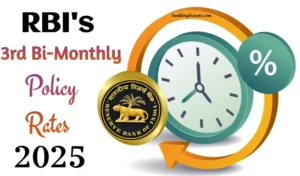In June 2025, the Reserve Bank of India (RBI) held its regular monetary policy meeting.
This is when RBI decides key interest rates and makes plans to keep the economy stable.
The Reserve Bank of India (RBI) usually reviews and can change policy rates six times a year.
The June update brought major changes, aimed at helping people and businesses by making borrowing cheaper and improving cash flow.
What Did RBI Announce?
Repo Rate Cut
The RBI cut the repo rate by 0.50%, from 6.00% to 5.50%.
The repo rate is the rate at which RBI lends money to banks. A lower repo rate means banks can borrow money more cheaply—and this usually leads to lower loan interest rates for people like us.
Example: If you’re paying an EMI on a home loan, there’s a good chance your monthly payments will now go down.
Policy Stance Changed to “Neutral”
Earlier, RBI had an “accommodative” stance, meaning it was focused on supporting growth even if inflation was a little high.
Now, it has moved to a “neutral” stance, which means it will carefully watch both inflation and growth before making any more changes.
This makes the RBI more flexible and cautious.Cash Reserve Ratio (CRR) Reduced
The CRR was cut by 1%.
CRR is the portion of money that banks must keep with RBI and cannot lend out. Lowering CRR means banks can lend more money, which can boost loans for businesses and individuals.
Other Interest Rates Lowered Too
- SDF (Standing Deposit Facility): Cut to 5.25%
- MSF (Marginal Standing Facility) and Bank Rate: Reduced to 5.75%
These rates affect short-term borrowing between banks and RBI.
Why Did RBI Made These Changes?
RBI shared a few clear reasons for its decision:
Low Inflation
Prices of goods are rising slowly, with inflation around 2.8% to 3.2% — well below RBI’s target of 4%. That gives room to cut rates without risking high inflation.
Weak Credit Growth
Even though banks have enough money, they’re not giving out many new loans. Cutting rates is meant to encourage more borrowing and boost the economy.
Support for Economic Growth
India’s economy is slowly improving, but needs help. Cheaper loans can encourage businesses to invest and people to spend more—both of which are good for growth.
Liquidity Management (Handling Extra Money in the System)
Right now, there’s too much cash floating around in the banking system. To avoid this causing problems, RBI used a reverse repo auction to absorb ₹1 trillion in excess funds. This keeps overnight interest rates from falling too low.
How Does This Affect You?
- Cheaper Home, Car, and Education Loans: Banks are already lowering interest rates, so your EMIs may reduce soon.
- Easier for Small Businesses to Borrow: MSMEs can get cheaper loans to grow and create jobs.
- Savings Interest May Go Down: On the flip side, interest on savings accounts and FDs may also drop.
What’s Next
- Watch Inflation: RBI will monitor prices closely. If inflation rises, rate cuts may stop.
- See How Loans Respond: If people start borrowing more, the cuts will be seen as successful.
- Global Uncertainty: RBI is also keeping an eye on global events like oil prices and foreign economies.
Conclusion
The RBI’s June 2025 monetary policy is a bold move to boost growth, improve liquidity, and support borrowers. With inflation under control, RBI used this opportunity to cut rates and make money more accessible.
This is good news for:
- People with home loans or plans to buy something big
- Businesses wanting cheaper credit
The economy overall, as more spending and investment can bring growth Still, you should stay informed—because how banks respond will affect your real-life finances.


Leave a Comment